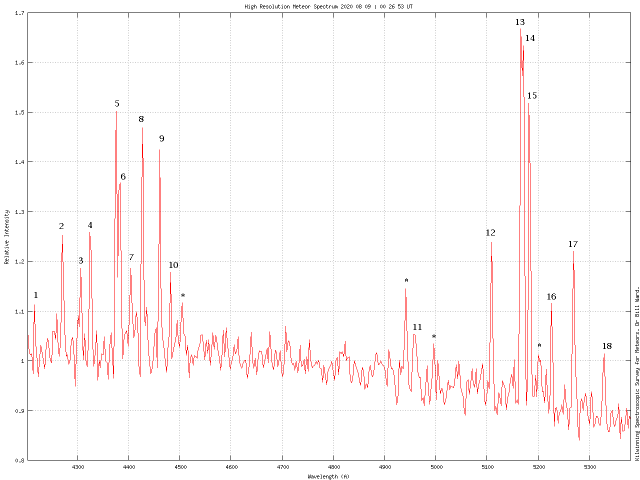- This topic has 6 replies, 3 voices, and was last updated 5 years, 3 months ago by
 Bill Ward.
Bill Ward.
-
AuthorPosts
-
10 August 2020 at 1:05 pm #574696
 Bill WardParticipant
Bill WardParticipantHi all,
Whilst observing the Perseids one of my HD spectro systems picked up a most interesting spectrum. It had some interesting features that suggested it was something special. It was also extremely bright as I caught the 2nd AND 3rd order!
Checking with the NEMETODE group revealed that several observers had also captured it. It turned out to be a -3 Alpha Cap.
This is a very rare spectrum and it is by far the highest resolution of any meteor spectrum I’ve ever captured.
Below is the crop of the 3rd order. It shows the Mg triplet fully resolved and the Na doublet is also seen to be split. The overall characteristics are of a normal rocky composition. The parent body being 169P/NEAT a comet but also of asteroidal character identified as 2002 EX12 which was found to be weakly active at perihelion and re-named with it’s comet designation.
The sodium line is quite strong so the meteoroid may be relatively “young”.

There are many lines to identify and more analysis to follow.
cheers,
Bill.
10 August 2020 at 3:43 pm #582986 Daryl DobbsParticipant
Daryl DobbsParticipantJust curious when was the spectrum taken as around 23:30 BST on Saturday night a bright red meteor in the west was reported on the Facebook Valleys Astronomy group page. The observation was made from South Wales.
10 August 2020 at 6:09 pm #582988 Bill WardParticipant
Bill WardParticipantHi,
Should’ve put the date/time info in the post! No, this was 0026 9th Aug 2020.
Bill.
10 August 2020 at 10:35 pm #582990 Bill WardParticipant
Bill WardParticipantHi all,
After further observations by the NEMETODE guys it appears the meteor wasn’t an Alpha Cap. It now looks like a -4 sporadic fireball of asteroidal origin. So it was indeed a normal chunk of rock…
Cheers,
Bill.
9 September 2020 at 4:52 pm #583094 Bill WardParticipant
Bill WardParticipantHi,
Here’s a calibrated graph of the spectrum. Had a few headaches with this one as the spectrum isn’t the third order, it’s the second order. A bit of confusion with the image scale after 12+ years of working with spectra from WATECS…
A few “lines”, marked with an * are stellar artifacts and noisy pixels not real lines.

and here’s a list of list of catalogue lines closest to the “barycentre” of the spectrum line (as it’s called in VisualSpec)
Line Wavelength (nm) Element
1: 421.618 Fe I
2: 427.176 Fe I
3: 430.790 Fe I
4: 432.576 Fe I
5: 437.593 Fe I
6: 438.355 Fe I
7: 440.475 Fe I
8: 442.730 Fe I
9: 446.165 Fe I
10: 448.113 Mg II
11: 495.760 Fe I
12: 511.040 Fe I
13: 516.732 Mg I (Probable blend with 516.749nm Fe I)
14: 517.268 Mg I (Probable blend with 517.160nm Fe I)
15: 518.360 Mg I
16: 522.715 Fe I
17: 526.954 Fe I
18: 532.830 Fe IIf the spectrum had been a bit brighter, or shifted to either side a bit, perhaps other lines would have been observed. However as is, it looks like a simple composition of just iron, magnesium and sodium.
Interesting because it is rather un-interesting!
Cheers,
Bill.
13 September 2020 at 5:31 pm #583098 Mr Jack MartinParticipant
Mr Jack MartinParticipantBill,
A good result, more interesting than un-interesting !
Well done.
Jack
14 September 2020 at 9:21 pm #583107 Bill WardParticipant
Bill WardParticipantHi Jack,
Thanks. I have another very hi res spectrum (the Fe one) now with 60+ lines identified. This is currently with John Mason who wanted something for the Observing Notes in the Journal.
We’ll see what appears in the print but I’ll re-post the spectrum graphs here in due course.
Cheers,
Bill.
-
AuthorPosts
- You must be logged in to reply to this topic.
